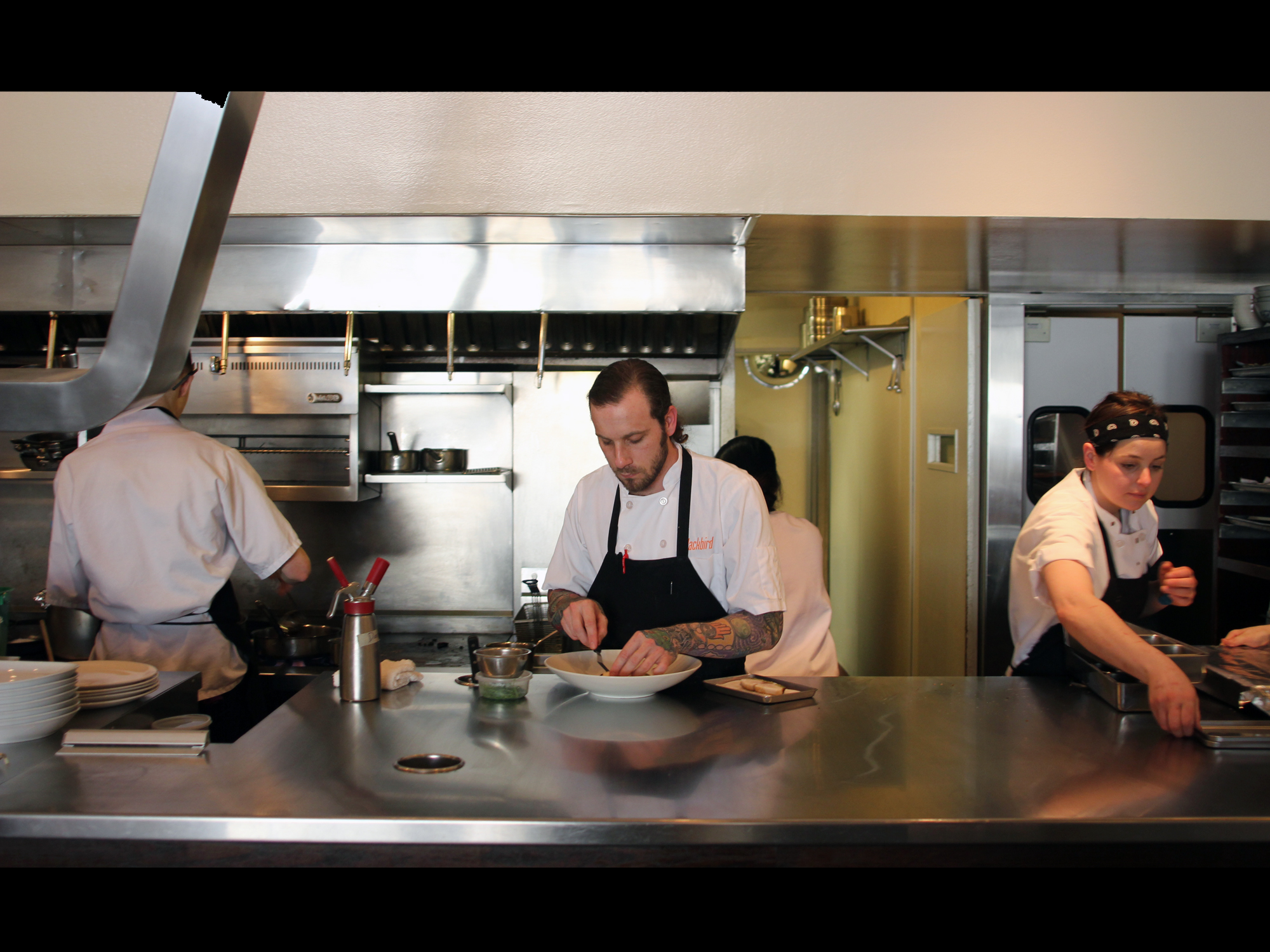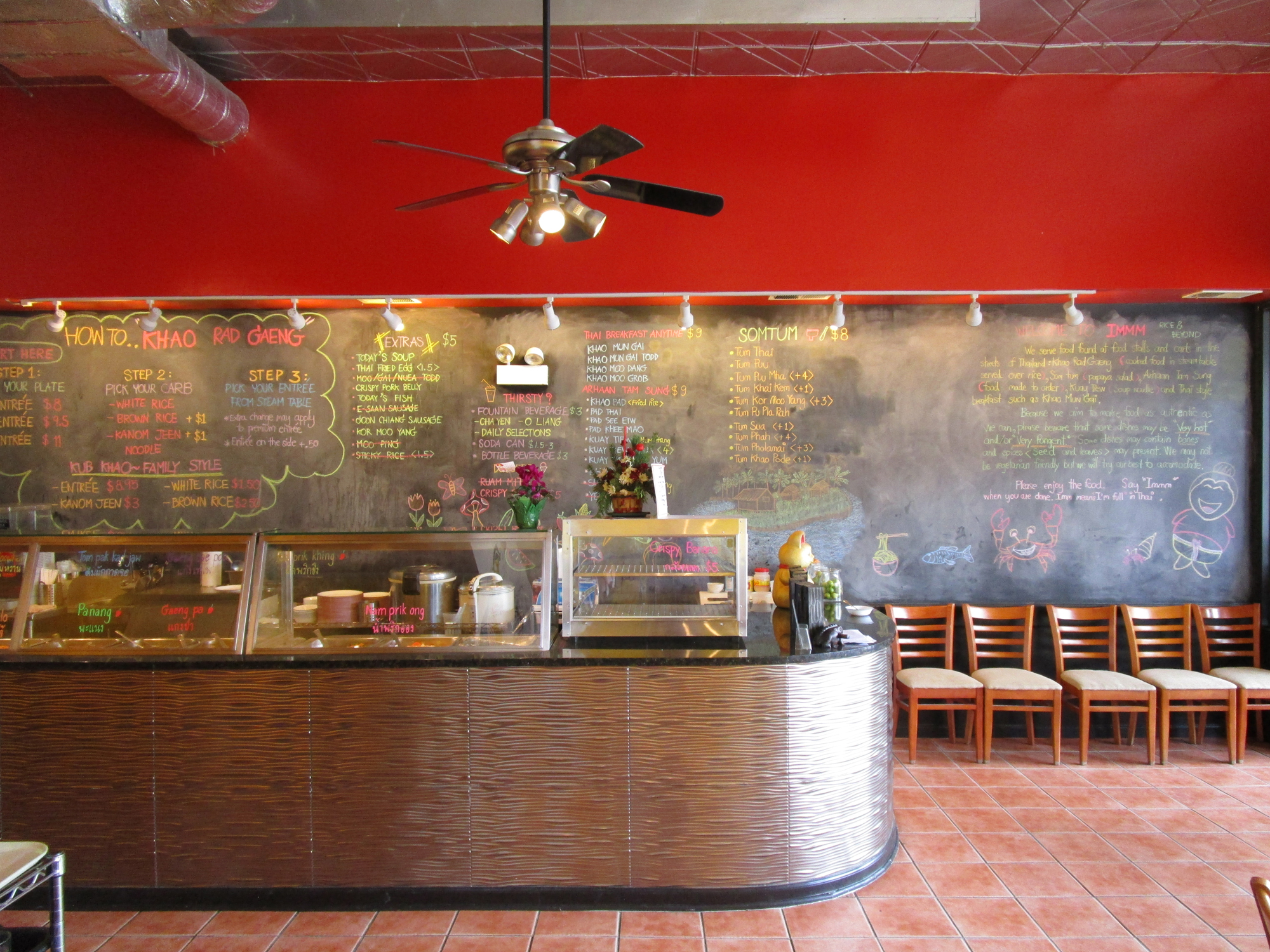THE FIRST THING THAT CAUGHT MY EYE on that day 27 years ago was a somewhat-garish paper sign plastered across the front window announcing, “BEST CHICKEN SOUP.” This was quite a matzo-ballsy claim to make, with longtime Jewish landmark Sam & Hy’s and its chicken soup variations—mish mosh, kreplach, matzo ball, not to mention a powerhouse chicken noodle–only two blocks away. Trying to add yet another soup to Skokie’s “Restaurant Row” along Dempster, where the choices at that time already ran from Gino’s East minestrone to Pita Inn’s lentil, had the potential of not ending well at all.
But upon further scrutiny, I saw that it was a Vietnamese joint making the claim, which beyond the sheer audacity, overjoyed me no end. Until then, anybody with the urge had had to drive to Uptown and the nexus of the Vietnamese community near the intersection of Broadway and Argyle to satiate a craving for crab and asparagus soup, tightly-wound egg rolls, lemongrass chicken and jasmine tea. Outside of that little universe there was nothing in the vicinity, certainly not near my home in Skokie. The predominantly Jewish suburb was virgin territory, for better or worse.
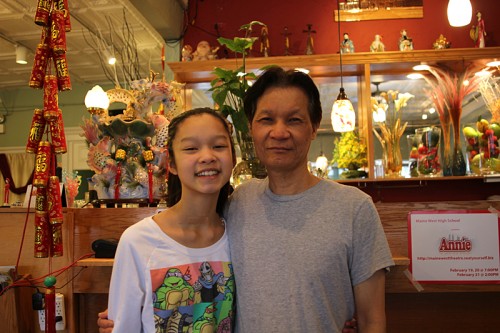
David Tran and daughter Angela
Walking into Annam Express that day in 1989 and seeing a young, skinny man controlling multiple woks and pots while sporting a “Pasteur” tee shirt, I immediately assumed this guy knew his stuff—because Pasteur in Uptown was the gold standard for Vietnamese food in Chicago, mainly thanks to Chicago Magazine anointing it such. Before the internet became our inside track to ethnic food, the back section of each issue of Chicago was the main gateway for anybody wanting to explore unknown ethnic cuisine in the city.
“I worked for Pasteur, cooking there from 1985 to 1989,” David Tran remembers. “At that time, I had a lot of customers from Skokie and some from Highland Park that would come down to Pasteur, and they recommended that I go to Skokie to open up. One of those customers was a friend from Highland Park, who passed away about ten years ago. He made that big sign and donated it to me to put in the window.”

Pho Dung Gia, on Miner street in Des Plaines, opposite the Metra station
I suspect Tran didn’t realize that that sign in that area was a provocation bordering on a prank. Guerrilla advertising notwithstanding, Annam Express soon became my family’s go-to Asian spot along that Restaurant Row, and we enjoyed the subtle differences in preparation from its Chinese equivalent.
“Basically I learned cooking from the Chinese,” Tran explains, “but it seemed to me there was too much oil used, and some of the vegetables were not fresh like I was used to—they were mostly from a can. That’s why I didn’t want to use that kind of ingredient. I would buy locally, fresh every day, and mostly we got the supply from the Argyle area in Uptown. No problem getting anything we needed.”
“Then I started testing my own method from that, from how I would like it to taste. I would invite some friends of mine to try these items that I would make, and I would tell them to let me know how it tasted. If ten people tried the item and six liked it, I’d say OK, that’s the way to do it. And little by little, that’s how I built up the menu.”
THERE’S NO CHOICE BUT TO BE drawn to Tran’s shy, unassuming personality, seemingly at odds in that respect with a prototypical business owner, especially one trying to forge a path in a sedentary suburb. Did he have reservations about taking the plunge in that respect?
“No, not at all. When I first came to this country I was 18, and I hadn’t worked in any restaurant in Vietnam. Once I was here, I went to school for a year learning English and I was in the restaurant business from the beginning, first as a cook at a Chinese restaurant near Washington, D.C. in Annapolis, Maryland. Then I opened up my first restaurant in Houston in 1981, serving American people, not only Asians,” Tran recounts pensively, alluding to the initial aversion by Americans to that cuisine so soon after the Vietnam War. “I’m not scared of anything.”
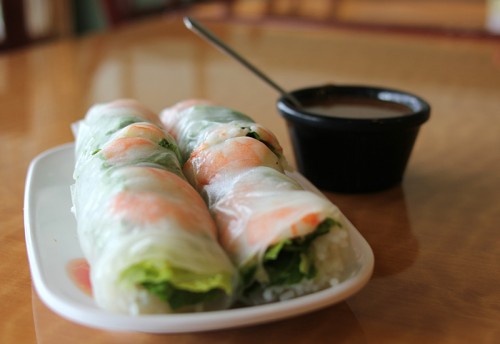
Goi cuon, Vietnamese spring rolls—a key gateway food to Vietnamese dining in the 1980s and 1990s
It’s not hard to see why a mere restaurant wouldn’t daunt him when you know his personal history. “I came to this country from Saigon in April 1975,” Tran says. “First we came to Camp Pendleton in California and we stayed there for about a month and a half.”
Saigon fell on April 30, 1975. Camp Pendleton outside of Los Angeles was hastily arranged by the U.S. Marines along with other tent cities across the country, preparing for an immediate influx of over 100,000 refugees. These camps at least had a semblance of order and the refugees were no doubt in a better place than they had been, but it was still a far cry from the promised land. And they were expected to move on from this temporary home and assimilate elsewhere in relatively short order.
“Basically I learned cooking from the Chinese. But it seemed to me there was too much oil used, and some of the vegetables were not fresh like I was used to.”
Uptown then was the Ellis Island of Chicago, the stream of Vietnamese, Cambodian and Laotian refugees that arrived from 1975-1980 mixing with the American blacks, Appalachian whites, Mexicans and American Indians already living there, and the younger Chinese seeking to get out from under the On Leong tong that dominated the south side Chinatown. These groups didn’t always mix peacefully, but Asian grocery stores and restaurants began sprouting up, with media helping lead non-Asians to Pasteur, Mekong and Hue, three of the first Vietnamese restaurants to attract non-Asian attention. By the time Tran opened his own restaurant, he knew what a mixed clientele would accept.
“When I opened in Skokie in 1989, the chicken soup was the most popular item because we had put the big sign up, and everybody has still followed us for that, ever since then,” Tran continues. “We sold a lot of chicken soup at first. And with the open kitchen at the Skokie store, everybody could see what I was cooking. At first, people were not used to some of the things on the menu, like the duck items that took a long time to prepare, so we took them out, no problem. But after a while, they started trying a lot of the other Vietnamese items in addition to the soup.”
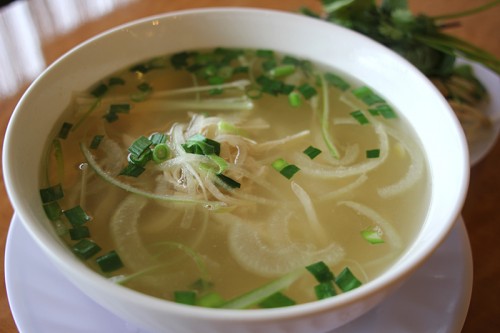
The soup
Yes, the soup. Tran’s rendition was simple but killer. Unlike the schmaltz-laden Jewish version at the competition down the street, this consisted of clear, clean, steaming broth with finely-chopped scallions, thin rice noodles and shards of moist chicken breast. There’s none of the beefy funkiness or star anise accents of the best-known Vietnamese soup, pho. Was it purposely Americanized to adapt to local tastes? Tran says not really, but it’s evident that the success of the chicken soup—familiar and yet with a simplicity that’s unmistakably Asian—hit its mark immediately with Skokie’s soup-fressers.
And in time, those who delved into the menu at Tran’s new restaurant also learned about the French influence on Vietnamese cuisine. A perfect example of the Franco/Viet mix is banh xeo, translated as “sizzling cake”, but resembling a crispy crepe folded in half and filled with goodies such as pork, shrimp, bean sprouts, green leaf lettuce and fresh mint, drizzled with nuoc mam, the ubiquitous native vinegar-based fish sauce. The thin baguettes used in banh mi sandwiches have a French character as well, as does the high-octane Vietnamese iced coffee, a potent mix of Café du Monde/New Orleans-style espresso and sweetened condensed milk poured over ice.
Another characteristic of the cuisine is the liberal use of fresh, uncooked herbs, mostly cilantro, mint, lemongrass, basil and watercress, which are not seen in such quantity in other Asian cuisines. It might not be wrong to assume that the corresponding healthiness from these ingredients—in striking contrast to Chinese food—happened to hit suburbia at exactly the right time.
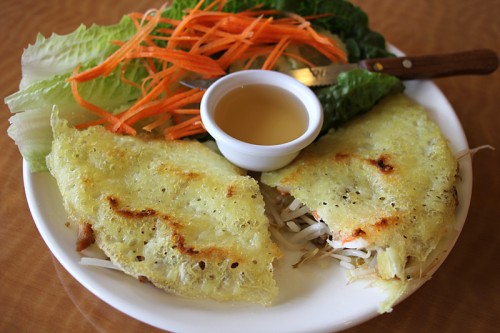
Seafood banh xeo
OVER TIME TRAN HAS SHOWN a similar pattern in his locations—start in a small storefront, and expand into the space next door. In 2000, after eleven years in Skokie, Tran decided to ply his trade in upscale downtown Evanston as Annam Cafe, hoping to grab a portion of the thriving dining scene there as well as to cater to the adventurous-but-budget-minded palates of Northwestern University students. Business was good, he said, but “we had trouble with the landlord raising our rent so much, so we left,” taking up his current spot as Dung Gia, or Pho Dung Gia (named for his parents), on the main strip of Des Plaines.
“With all the moves, we are happy that people found us through the Internet and keep coming,” Tran says.
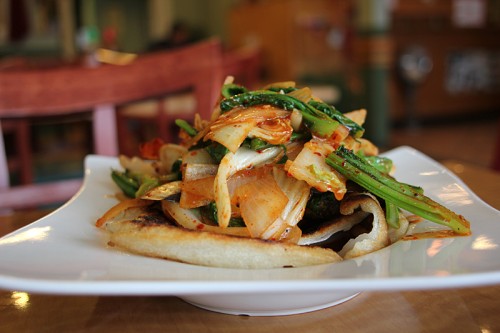
Seafood with fried noodles
Now almost nine years in his third location and suburb, his vintage, high-ceilinged, now-double-storefront restaurant seems to have lent a sense of stability to David Tran, wife Kathy and their three children. He is still working long hours as master chef while his ebullient brother-in-law Long runs the front of house. And in keeping with the popularity of pho among the Vietnamese residents and—recently—Americans, Tran has put his signature touch on that as well. It was inevitable, just like the chicken soup.
“People were opening restaurants everywhere with pho on the menu…” Tran says, and Dung Gia was to eventually be no different in that way. His pho bo tai features sliced rare beef and the requisite rice noodles, thinly sliced onion, scallions and fresh bean sprouts, cilantro and basil with optional hoisin and Sriracha sauces and a squirt of fresh lime juice. But its most distinctive (and positive) attribute, compared with other restaurants’ pho, is the clean flavor of the broth. Maybe this was borne out of his success story with the chicken soup, and he is doubling down on that. Or it could be his confidence that he’s in a good place now, restaurant location as well as country.
“I am happy with what I’m doing now,” Tran attests. “Happy with my family, happy with the education my children have gone through. This country is the best, everybody is helpful and friendly. They taught me little by little how it works, and I’ve learned a lot. I love it.”
Spending thirty-five plus years in the food business as a full-time tomato broker and part-time options and commodities trader have given Jay Martini a realistic sense of the supply and demand aspect of what we eat. And by taking cooking classes domestically as well as abroad, he has learned the value and importance of sourcing the perfect ingredients for the right dish. His stories often show admiration for the cooks and chefs that follow this practice.
Latest
Join the Discussion
After you comment, click Post. If you're not already logged in you will be asked to log in or register with Disqus.




